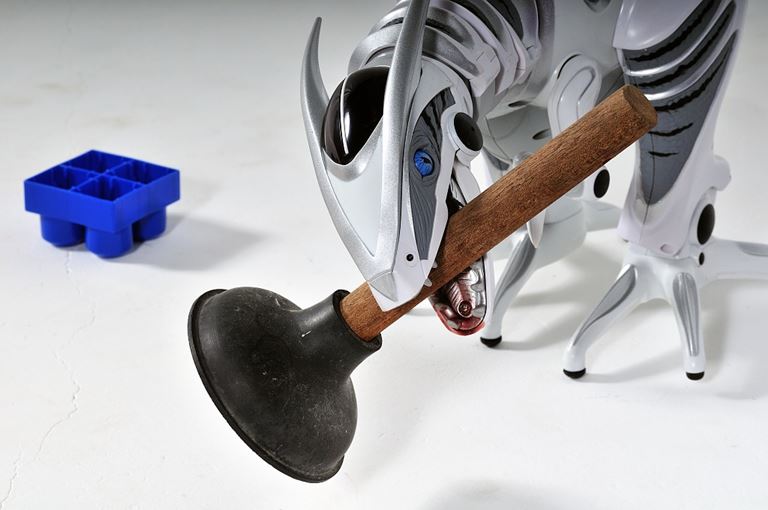
Plungers work in both directions. They move water back and forth inside the pipes, breaking up the blocking material into smaller bits until the clog can no longer hold itself together.
To do this, an airtight seal must be formed where the plunger meets the plumbing. Any leaks will mean at best an ineffective & noisy plunging and at worst a squirt of sewage back towards the user.
Maintaining this seal while the plunger is worked up and down, for as many as a dozen strokes or for as long as thirty seconds, is the most important consideration, and is why there are so many differently shaped plungers on the market. Hopefully you have the right plunger for your drain. If you don’t maybe you can still make it work.
Airtight seals cannot be formed if there are other outlets for air or water in the pipes surrounding the clog. Bathroom sinks and bathtubs will have one or more overflow drains, for example. These are drains, often hidden inside a lip of the sink or behind a metal plate with the stopper lever on a tub, which catch any overflow from the sink or tub. They connect directly to the same drain as the bottom of the sink or tub, so if you try to force water through the drain, it can come back up and out the overflow. The most common method for blocking these overflows so you can use a plunger is to stuff a wet rag or washcloth into them, so they are tightly blocked. Use a large enough cloth that it will not be in danger of falling or being sucked into the drain. You may find you need to hold these cloths in place, perhaps with a third hand.
Plungers work by moving water, not air. If you are clearing a slow drain, add enough water that you have some standing for the moment. If you are clearing a toilet, you want some liquid in the bowl, but not so much that it will splash out while you work. Do not flush a clogged or blocked toilet to add water! Fill a bucket in a sink, then add only as much as required to work the plunger, or bail out a brimming toilet to get some working space.
When applying the plunger to the drain and forming your initial seal, you want to fill the plunger chamber with liquid. Slide the plunger into standing water at an angle to scoop some up, removing as much of the ineffective, compressible air as possible.
Maintaining your tight seal between the plunger & plumbing, work the plunger both up and down, as far as the plunger and drain shapes allow. A slow swishing back and forth is much, much more effective than a quick jab. Expect to have to work the plunger up and down many times, for several seconds per attempt. You may need to check, add more water, and plunge multiple times to completely clear the clog.
When used properly, plungers are amazingly effective. For clogs that can be busted up, they are the right tool for the job. No home should be unprepared for a clogged toilet, so they are truly indispendible tools for both owners and renters.
 Toilet Plunger - Easy Clean with Free Bonus EbookSAVE SPACE - At 21" in height it fits easily in most cabinets or under most sinks.
Toilet Plunger - Easy Clean with Free Bonus EbookSAVE SPACE - At 21" in height it fits easily in most cabinets or under most sinks.
 LDR Bellows Type PlungerPlunger constructed with a design which allows for more pressure per square inch.
LDR Bellows Type PlungerPlunger constructed with a design which allows for more pressure per square inch.
 OXO Toilet Plunger* MOST POPULAR * Accommodates low-flush toilets, and features flat easy-push handle. A clamshell canister conceals when not in use.
OXO Toilet Plunger* MOST POPULAR * Accommodates low-flush toilets, and features flat easy-push handle. A clamshell canister conceals when not in use.
When clogs form in bathroom sinks, showers, bathtubs, kitchen & utility sinks, or shop & laundry drains—then the preferred tool will be a drain auger.
UncloggingDrains101.comLearn to use closet augers to unclog toilets. Tips and hints for success using handheld drain snakes on blocked commodes
UncloggingDrains101.comWhen you have a toilet plunger, you are well prepared for clearing clogs made up of anything softer than a rubber ducky.
UncloggingDrains101.comEverything about unclogging floor drains, from the toughest job to the quickest maintenance
UncloggingDrains101.comLearn how to use the common drain snake and be prepared to do-it-yourself when it comes to slow or stopped drains in the home
UncloggingDrains101.comWhen clogs form in bathroom sinks, showers, bathtubs, kitchen & utility sinks, or shop & laundry drains—then the preferred tool will be a drain auger.
UncloggingDrains101.com